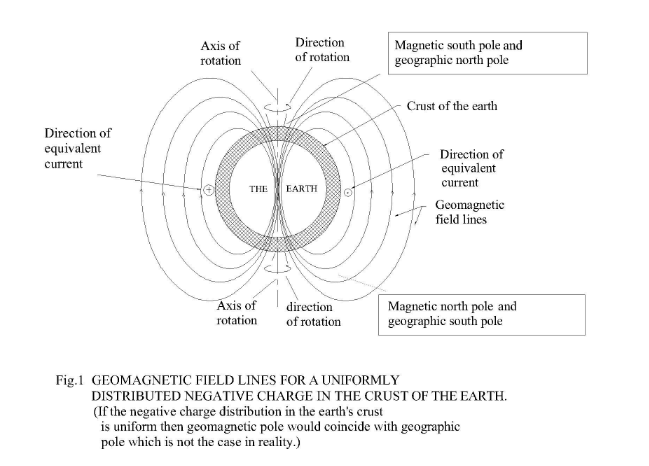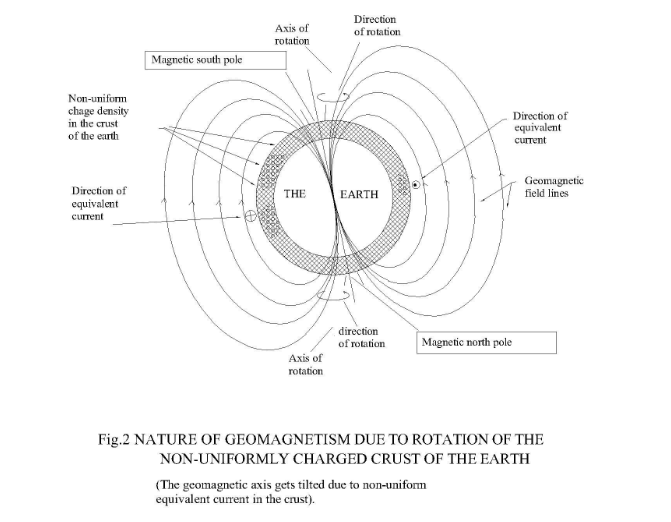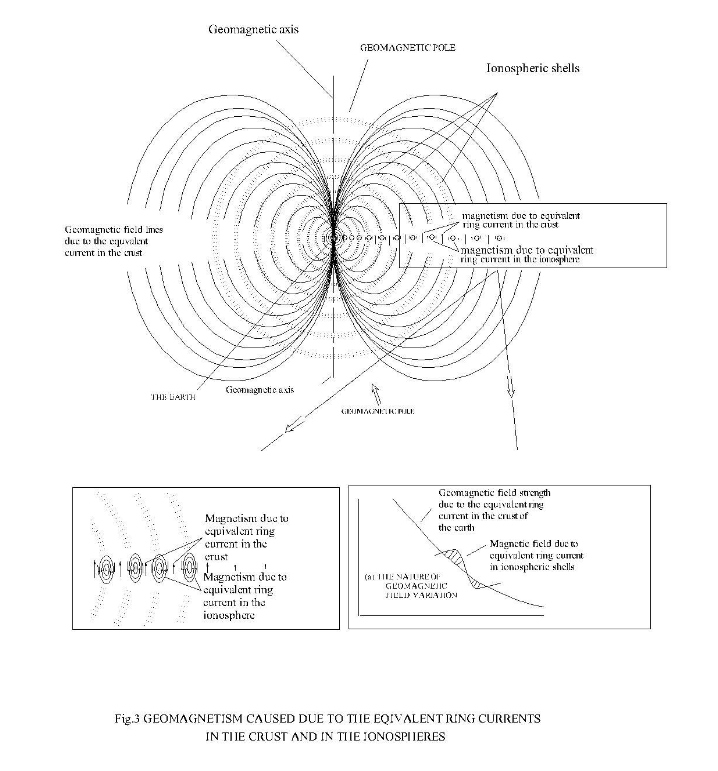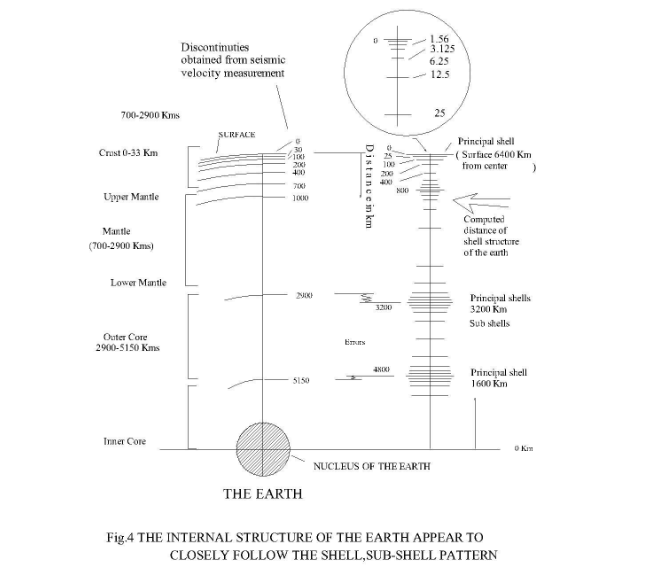INSTITUTE OF PHILOSOPHY OF NATURE
Abstract
Extensive data on the nature of geomagnetism and different methods of analysis is available today. Despite all these, the origin of earth’s magnetic field is not very clear. Various hypotheses made to explain geomagnetism appear unrealistic and they have many limitations. This article makes a new approach to understand the cause of geomagnetism from the equivalent ring current in the earth’s crust and ionosphere. The earth’s crust is negatively charged and it is electrically conductive due to presence of free electrons. The rotation of earth carrying negative charge in the crust develop an equivalent ionic current that induces geomagnetism. This geomagnetic field is further modified by solar-terrestrial interaction. Recently the positive charge state of the sun has been reported. The positive charge of sun attracts the free electrons in negatively charged shells of the earth’s crust and ionosphere thereby polarizes the free electron structure. The charge polarized structures in earth’s crust and ionosphere remain fixed with respect to the sun even though the earth rotates about its axis. The rotating earth tries to carry the free electrons along with the crust but the charge polarized structure being fixed with respect to the sun, the free electrons do not move. Hence the free electrons make a relative motion with respect to the earth. This produces an equivalent electronic ring current in the crust of the earth as well as in the ionosphere which modifies the geomagnetism. This new analysis justifies the exact nature of geomagnetism and its variations. It also explains why the fossil magnets exhibit opposite polarity at different depths without the consideration of reversal of polarity.
Key words: geomagnetism, earth’s magnetism, geomagnetic field, origin of geomagnetism.
Introduction
The earth’s magnetic field is known from a quite long time. However, during the last century, large volumes of measurement data have been reported from various magnetic observations. These data are further supplemented with good amount of global coverage with the help of satellites. Despite the availability of huge data and modern method of analysis, the origin of earth’s magnetic field remains as one of the unsolved problems [1].
Before 1600 AD William Gilbert investigated the variations of magnetic force over the surface of a spherically cut magnetized mineral, lodestone, and concluded that the earth behaved, as if, it is a uniformly magnetized sphere. He further supposed that the cause of magnetism lies within the earth itself. In the year 1939 Gauss derived mathematically the earth’s magnetic field through spherical harmonic analysis and showed it to be as that of a uniformly magnetized sphere which implies a dipole magnet at the centre of the earth. It may be noted here that the spherical analysis is nothing more than a mathematical analysis to represent the field by means of a hypothetical source at the center. It is necessary to understand the nature of geomagnetism before proceeding to comment on the origin of the same. The magnetic axis has an offset inclination with the geographic axis. The Earth’s geographic axis and magnetic axis are not coplanar. The magnetic axis is inclined at an angle of about 11.3 degrees with the geographic axis [2]. Though the earth’s magnetic field always correspond to a dipole magnet, it varies spatially responding to different time of the day, season etc… The time dependent changes are of two type’s viz. short-term transient variations and the long-term secular variations due to reason associating the main field. Daily magnetic records show, in some days, the field exhibits smooth and regular variations while in other days it is disturbed with irregular fluctuation. Obviously, these transient variations are due to solar-terrestrial relationship. In general, both day-to-day changes of intensity in disturbed days and those in the magnetically quiet days are of similar pattern over a wide area. Sudden magnetic storm occurs worldwide and happens almost at the same time within a margin of half minute. The magnetic disturbance in the auroral zone is higher than those at low latitudes. Occasionally the values exceed 5000gauss. Besides the large-scale disturbances, the abrupt impulsive changes with variations lasting from 0.1 sec to 10 min. also occur which are known as magnetic micro pulsation [3].
Secular variations on long term scale are noticed from the successive mean values of the magnetic element from any particular station. The secular variations have different values from place to place which may be anomalously large or small. It is also noticed that the dipole moment of the earth’s field is in decreasing trend with 6% drop during the last century [3]. It is interesting to note here that the decrease of dipole moment, however, has little effect on the inclination of dipole axis. Geological studies of magnetic behaviour of underground rocks and minerals reveal that geomagnetism has undergone reversal of polarity many times in the past. The above prior information is useful in finding the origin of geomagnetism as the new model has to account for the above observed features of geomagnetism.
Progressive Change of Concept on the Origin of Geomagnetism
Different hypotheses have made impact at different times to account for the nature of geomagnetism but none could stand the test of time as they have been proven inadequate and unrealistic.
First Hypothesis:
The first assumption was that a permanent magnet exists in the earth. This assumption does not stand in the light of high temperature inside the earth. The temperature gradient in the crust is approximately 30 K/kilometre. Thus, at a depth of 25 km, the temperature is in the order of Currie point of iron [4]. Therefore, at greater depths, the Ferro-magnetic substances would have lost their permanent magnetism. Hence, to account for the earth’s magnetic moment, an average intensity of permanent magnetisation in the earth’s crust of about 6gauss is necessary. For most rocks the intensity is less than 10-2 gauss [4]. Therefore, the permanent magnetism concept is a failure. It also fails to account for other features of earth’s magnetic field such as the close proximity of the magnetic and the geographic poles, the secular variations and the reversal of polarity.
Second Hypothesis:
When the permanent magnetism concept failed, it was thought that a possible source seemed to be some form of electromagnetic induction caused by electric current flowing in the earth’s electrically conducting fluid core. The palaeomagnetic measurements have shown that the earth’s main field has existed for 3500 million years [5] and that its strength has never differed significantly from its present value. However, in a bounded electrically conducting body, any system of current would decay and this value for the earth is 10,000 yrs. Thus, the geomagnetic field cannot be a relic of the past [5]. Therefore, a mechanism must be found for generating and maintaining electric currents to sustain the magnetic field.
Third Hypothesis:
It was then thought that the source of electromotive force needed to maintain the currents is the motion of core material that behaves like a dynamo. The argument put forward here is that the core is a good conductor of electricity and it is a fluid that can permit mechanical motion causing a flow of current. The above interaction could generate a self-sustained magnetic field. It is further said that gravitational and heat energy sources are available at the core of the earth for running the dynamo. Thus, everything is available except the critical problem how to show the inductive reaction to an initial field [7]. A real man-made dynamo is much more than that discussed above. A man-made dynamo is exceedingly non-homogeneous containing rotor, stator, wire with typical winding, bearings, insulation etc. whereas the fluid core is essentially homogeneous and isotropic. It must be expected that any such dynamo would be short circuited [6]. The intricacy of the problem can be well realised by an electrical engineer as to how difficult it is to assume the operation of a dynamo in the earth’s core.
A New Concept on Origin of Geomagnetism
Various measurements have established the negative charge of the crust of the earth. It is further noticed that the atmosphere of the earth is also electrically charged with alternate positive and negative polarity [7]. Thus, the earth can very well be considered as a negatively charged celestial body. Now, if an orbital body, say the earth, in the solar system is negatively charged like the orbital electrons in atomic system, then, there is every possibility that the nucleus of solar system (the sun) be positively charged in the light of the positively charged atomic nucleus. This author has shown elsewhere [] how the sun is positively charged. The charge aspect of celestial body has the merit of explaining many features of the earth and its atmosphere including geomagnetism with distinct clarity.
Any amount of positive charge earthed (discharged into the crust of the earth) does not change the negative charge state of the ground. Hence, the earth carries huge negative charge in its crust. The earth carrying negative charge in its crust rotates from west to east (anticlockwise- viewed from north pole end). The negative charge (negative ions and attached free electrons) present in the crust of the earth also rotate from west to east along with the crust. The rotation of the earth makes rotation of negative ions and attached free electrons about the axis of the earth. This produces an equivalent ring current from east to west (Fig.1). Referring to figure-1, the symbol ʘ indicates direction of current towards the observer and the symbol indicates the direction of current away from the observer. The negatively charged earth with rotation about its own axis is equivalent to a solenoid (dipole electro magnet). For an equivalent solenoid carrying east-west current, the induced electro-magnetic field exactly matches with the nature of geomagnetism i.e., the magnetic north pole being located near the geographic South Pole and the magnetic South Pole located near the geographic North Pole. There is a definite reason why the magnetic poles do not exactly coincide with the geographic poles. This happens due to non-uniform equivalent-current density along the crust of the earth. The negative charge density of the crust is a function of crust composition, sea-land distribution etc. The sea water having a better electrical conductivity carry much more negative charges than the dry land. The magnitude of equivalent current in the crust at any location is directly proportional to the negative charge density at that location. The unsymmetrical distribution of sea water and land mass in the crust forms a solenoid with varying equivalent currents in its path that gives rise to a dipole magnet with its magnetic axis making an offset angle of 11.3 degree with the geographic axis (Fig.2). The functioning of a hypothetical dynamo operating at the core of the earth as envisioned in present science is not required to understand the cause of geomagnetism. The geomagnetic field is further modified by other modes of equivalent current systems in the crust and ionospheres [8].


The sun is now known to be positively charged [9] and the earth’s atmosphere has alternate positively and negatively charged ionospheric shells. The charge particles in the earth’s crust and its atmosphere experience charge interaction with the sun. The charge attraction from the sun is not enough to move the free electrons attached to the matters in the crust. The charge particles in the ionospheric shells are free to move in their respective shells but they are restrained to move vertically due to earthly charge polarized structure. The free electrons and negative ions in negatively charged ionospheric shells are free to move along their respective shells to crowd at location nearest to the sun (location corresponding to mid-day sky). The crowding of free electrons and negative ions in negatively charged ionospheres in the mid-day sky attract the positive ions in the positively charged ionospheres to also accumulate in mid-day sky. The positive ions in positively charged ionospheres are repelled by the positively charged Sun causing accumulation of positive charge in the far side of the ionosphere that corresponds to midnight sky. The negative ions are also congregated in negatively charged ionosphere in the mid night sky due to the crowding of positive ions in positively charged ionosphere. This new consideration provides an alternate explanation to the formation of ionospheres having the charge density peaks during both mid-day and mid-night sky. The existing concept of formation of ionospheric peaks by ionizing solar radiation alone has limitations in explaining the conspicuous charge density peak in the mid-night sky. The formation of ionosphere and its features are discussed in article-2, issue-2, volume-2, Towards Unification of Sciences.
Magnetic field at far distance from the earth
The free electron configuration in the negatively crust and negatively charged ionospheric shells remains always oriented towards the sun and it does not rotate along with the rotation of the earth and its atmospheres. It amounts to a relative motion of free electrons in the reverse direction with respect to the rotation of earth. This produces an equivalent electronic current in the direction of rotation of the earth. The negative ions in negatively charged ionosphere rotate in the direction of the rotation of the earth producing an ion current in opposite direction of rotation of earth. On the other hand, the free electron structure remaining fixed with respect to the sun does not move along with the rotational motion of the crust and ionosphere, thereby produce an electronic ring current in the direction of rotation of crust and ionosphere. Thus, the magnetism produced by ionic current brings modification in the main geomagnetic field, while the magnetism produced by electronic current opposes the geomagnetism. The positive ions in the positively charged ionosphere also produced ion current in the direction of rotation of the earth and super impose its effect on the main field. The above current modes make spatial variations in magnitude and direction of main magnetic field at different levels of atmosphere. Positive ions are more diffused in the positively charged ionospheres, hence the magnetic field produced by the ionic current by motion of positive ions is also diffused. But, the electrons and the negative ions in negatively charged ionospheres being more compressed in the form of a pan-cake give rise to high density equivalent currents which results in prominent magnetic induction locally.
The equivalent ring currents in ionospheres produce secondary magnetic field that modifies the main geomagnetic field produced by rotation of negative charges in the crust of the earth. Due to the formation of charge shells with alternate polarity, the spatial magnetic field varies considerably. The field becomes weak at some place and strong at some other depending on the nature of magnetic vectors of main and auxiliary geomagnetic field (Fig.3). This explains alternate increase and decrease of geomagnetic field having directional changes with altitude. Thus, at far away atmosphere when both magnetic fields oppose one another, the net field may become zero and where the field is additive, it becomes prominent. This develops discrete patches of magnetic field in far distances. The discrete appearance of geomagnetic field is, at present, erroneously attributed to the effect of solar magnetic field lines. For example, beyond 15R there is a discontinuity and it again appears at >30R, R being the radius of the earth [10].

Reversal of Polarity
The concept of reversal of polarity has come from the study of the nature of permanent magnetism seen in the fossils at different depths [11]. It is extremely difficult to think of self-induced reversal of rotation or reversal of geographic polarity to justify the opposite magnetic polarity in fossils-magnet at different depth. Geologists conform that the earth has undergone reversal of polarity several times in the past. If reversal of polarity of earth is a natural phenomenon then the axis of earth would not have maintained a fixed inclination for a pretty long period. Hence, the reversal of polarity is not a reality and the exact cause fossil magnetism with opposite magnetic polarity is required to be justified from different concept. In the light of the occurrence of ionospheric layers with opposite charge polarity, one may find that the negatively charged crust of the earth to have a vertical charge gradient of negative charge density decreasing with depth (Fig.4).

The vertical earth-current records also agree with this fact. Such a charge gradient is likely to cause charge polarisation in the layered structure of the crust materials having different dielectric constants. This develops alternate positively and negatively charged layers in the earth’s crust. The negatively charged layers contain free electrons and the free electron density is highest at mid-planes of the layers. Hence, the current density in negatively charged layer is highest at the mid-plane. The current density further rises in highly conducting narrow paths within the crust. Because the electrical conductivity at different location within the negatively charged shell varies. This produces strong electronic ring current locally in the direction of the rotation of the earth. For a plate (thin layers) carrying high current produces strong magnetic field lines on opposite faces of the plate. The magnetic field lines are directed oppositely on opposite faces of the current carrying plate. Hence, permanent magnetism with opposite magnetic polarity is induced in the fossils on opposite sides of current carrying plate.
The short-term transient variations and the long-term secular variations of geomagnetism is now justified from solar terrestrial relationship i.e., with the variation of solar wind. The changes in the sun such as the solar flare cause variation in the nature of solar wind which makes fluctuations in the charge density in different ionospheres. These in turn causes fluctuation in the equivalent ring current in ionospheres making fluctuations in the geomagnetic field.
Conclusion
The new charge concept of celestial bodies provides a simple explanation of the origin of geomagnetism. This new concept does not make any unrealistic hypothesis like the operation of a magneto-hydro-dynamics at the core of the earth. It is also not required to assume a reversal of polarity for justifying the occurrence of reverse polarity permanent magnet in fossils at different depths of the crust. The negatively charged earth with charge polarized shells in the crust and atmosphere having alternate charge polarity cause equivalent ionic and electronic ring currents in the crust as well as in ionospheres which produce geomagnetism by electromagnetic induction. The earth’s magnetic field is further modified by solar-terrestrial interaction.
This article is a part of the original work published in the book “Planetary electrodynamics-I”, Volume-1 of the series “Dynamics of universe; interplay of matter, space and charge”, 1998 by the same author.
References
- Jacobs, J.A., Encycl. of Sc. & Tech., Vol-6, 1987, p.107.
- https://flexbooks.ck12.org/cbook/ck-12-middle-school-earth-science-flexbook-2.0/section/2.5/primary/lesson/direction-on-the-earth-ms-es.
- Jacobs, J.A., Encycl. of Sc. & Tech., Vol-6, 1987, p.714.
- Jacobs, J.A., Encycl. of Sc. & Tech., Vol-6, 1987, p.112.
- Ibid, p.114.
- Ibid, p.115.
- https://philosophyofnature.org.in/natural-electric-charge-structure-in-earth-and-its-atmosphere.
- https://philosophyofnature.org.in/analysis-of-earth-current-and-the-nature-of-variation-of-electric-potential-of-the-earth.
- https://philosophyofnature.org.in/similar-state-of-matter-of-nuclei-in-different-domains.
- Edward W. Hones, Jr. Sc. American, March 1986, p.32.
- Jacobs, J.A., Encycl. of Sc. & Tech., Vol-6, 1987, p.118.
